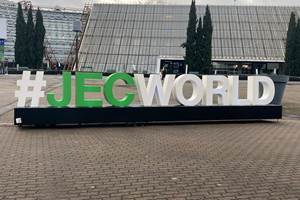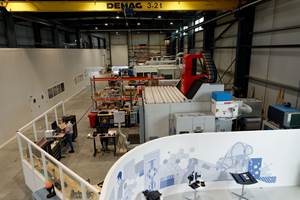Polyurethanes: Collaboration and adaptation for optimal application
Guest columnist Kevin Meyer, associate scientist, Dow Polyurethanes, The Dow Chemical Co. (Midland, MI, US), asks, and suggests some answers to, the question, "Why have polyurethanes, given their performance advantages, not been adopted in place of other thermosetting resins in a host of applications?"
Polyurethanes resins (PURs) are a group of polymers formed by the reaction of two molecules: an isocyanate and a polyol. Such a simple reaction suggests a simple product but, in fact, this polyaddition reaction yields one of polymer chemistry’s most complex and diverse set of reaction products. PUR technology, after more than 50 years, exhibits a wide range of end-products with an even wider range of properties: foams, elastomers, coatings, adhesives, sealants, fibers and films1. The fundamental PUR building blocks allow for customization in many areas, including glass transition temperature (<25°C to >200°C), thermal properties (linear molecules to highly cross-linked structures) and mechanical properties (soft elastomers to hard thermosets and thermoplastics)2. But, to date, PUR chemistry in composites applications has been limited, accounting for only about 3% of the total composites resin market3.
PUR chemistry in fiber-reinforced composites, however, is a natural fit because the PU matrix exhibits many characteristics that are superior to matrices of epoxy, polyester and vinyl ester. PUR-based chemistry has long been known for greater toughness than other thermosetting resins due to the high flexibility and elongation of its cured polymer structure. PU formulations can be tailored to a wide range of processing conditions and desired final properties due to the tailorability of the polyol’s backbones.4 Also, in pultrusion processes involving carbon fiber reinforcements, greater fiber/matrix adhesion has been observed with PURs than with polyester, vinyl ester or epoxy.5 So why then, given its performance advantages, has PUR not been adopted in place of other thermosetting resins in a host of applications?
A major hurdle to widespread adoption has been the high degree of reactivity of the mixed PUR system compared to other thermosetting chemistries. Even the most optimized two-component traditional polyurethane system exhibits gel times an order of magnitude faster than its epoxy counterpart. Processing with PUR, therefore, is difficult because most conventional composite manufacturing operations have been designed around thermosetting resins with a much longer pot life. Additionally, the isocyanate in the two-component system readily reacts with water (i.e., moisture/humidity) to form carbon dioxide that causes bubbling (voids) in the laminate structure. It’s no wonder, then, that when PUR is used in processes designed for thermoset resins with longer pot lives, poor part performance results.
Accelerating the growth of PUR chemistry into widespread composite applications will take a more collaborative approach from the entire value chain including resin suppliers, machine manufacturers and composites fabricators. An excellent example of such collaboration has already enabled polyurethane pultrusion. Traditional pultrusion operations use an open bath for coating and impregnating the fiber with resin before feeding the coated fibers into a heated die to form and cure the part. The open bath design is simple, easy to use and most importantly reflects the needs (or lack thereof) of the particular chemistries (esters or epoxies).
PUR-based pultrusion, however, requires a closed method to minimize interaction with environmental moisture. It incorporates in-line mixing and injection technology (in place of the open bath) and a contraction die design that facilitates homogenous fiber wet out. The injection and impregnation technology requires additional tooling from the manufacturer that is attached to the front of the curing die. To make the tooling as small as possible, very low-viscosity resins have been designed to facilitate fast and efficient wet out without sacrificing final part performance. This combination of tooling and chemistry took place at a pultruder’s facility. The pultruder provided valuable feedback based on decades of pultrusion experience to adjust the tooling and chemistry. Today’s method of closed polyurethane pultrusion minimizes waste, eliminates VOC emissions and enables pultruders to run faster line speeds at lower pull forces compared to open-bath technology. Further, it wouldn’t have been possible without contributions from collaborators with different backgrounds and experience.
New chemistries, like PURs, should be embraced because they encourage us to rethink production processes throughout the value chain. Simply dropping a highly reactive resin into a conventional process may not provide a desirable result. But, tweaking process conditions to accommodate the nuances of the chemistry might result in significant cycle time reduction. Or, redesigning the process, as described with the pultrusion process above, can yield significant benefits by reducing or eliminating waste with a one-time tooling expense. Large steps forward in technology are never easy, but when all parties in the value chain add their efforts, the sum is much greater than the individual parts.
References
1 R. Herrington and K. Hock, eds., Flexible Polyurethane Foams, 2nd Ed., The Dow Chemical Co. (Midland, MI, US), 1997.
2 M. Sonnenschein and W. Koonce, “Polyurethanes” in Encyclopedia of Polymer Science and Technology, 4th Ed., John Wiley & Sons Inc. (Hoboken, NJ, US), 2012.
3 “Growth Opportunities in Global Composites Industry: 2013-2018,” Lucintel LLC (Irving, TX, US), 2012.
4 M. Sonnenschein, Polyurethanes: Science, Technology, Markets and Trends, John Wiley & Sons Inc. (Hoboken, NJ, US), 2015.
5 G. Bramante, L. Bertucelli, A. Benvenuti and K. Meyer, “Polyurethane Composites: A versatile Thermo-set Polymer Matrix for a Broad Range of Applications - Mechanical Analysis on Pultruded Laminates,” Proceedings of Polyurethanes 2014 Technical Conference (Dallas, TX, US), 2014.
Related Content
JEC World 2024 highlights: Glass fiber recycling, biocomposites and more
CW technical editor Hannah Mason discusses trends seen at this year’s JEC World trade show, including sustainability-focused technologies and commitments, the Paris Olympics amongst other topics.
Read MoreAirbus works to improve the life cycle of composites in future aircraft
This companion article to CW's September 2024 Airbus Illescas plant tour discusses recycling, LCA, biocomposites, Fast Track technologies, qualification and more.
Read MoreWatch: A practical view of sustainability in composites product development
Markus Beer of Forward Engineering addresses definitions of sustainability, how to approach sustainability goals, the role of life cycle analysis (LCA) and social, environmental and governmental driving forces. Watch his “CW Tech Days: Sustainability” presentation.
Read MorePlant tour: Daher Shap’in TechCenter and composites production plant, Saint-Aignan-de-Grandlieu, France
Co-located R&D and production advance OOA thermosets, thermoplastics, welding, recycling and digital technologies for faster processing and certification of lighter, more sustainable composites.
Read MoreRead Next
A new "tunable" polyurethane could revolutionize composites
A novel polyurethane-based resin system with tailorable pot life and cure, from Huntsman Polyurethanes (Auburn Hills, Mich. and Everberg, Belgium) now permits composites manufacturers to tailor resin pot life and onset of cure to fit the processing requirements.
Read MoreScaling up, optimizing the flax fiber composite camper
Greenlander’s Sherpa RV cab, which is largely constructed from flax fiber/bio-epoxy sandwich panels, nears commercial production readiness and next-generation scale-up.
Read MoreCeramic matrix composites: Faster, cheaper, higher temperature
New players proliferate, increasing CMC materials and manufacturing capacity, novel processes and automation to meet demand for higher part volumes and performance.
Read More











